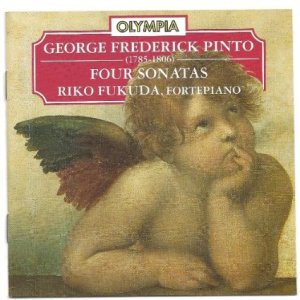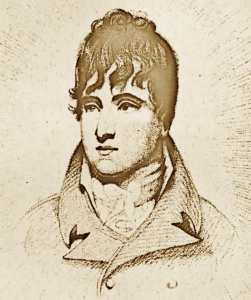George Frederick Pinto was born in Lambeth, England on 25 Sept 1785 and died Chelsea [now in London], 23 March 1806.
English composer of mixed ancestry. His father’s name was Samuel Saunders or Sanders, but he took his surname from his mother Julia Pinto, daughter of THOMAS PINTO and herself the composer of a published vocal duet, The Morning (c1788). His early musical talents were nurtured by his mother and his step-grandmother, the singer Charlotte Brent. He began studying the violin very early, and at eight became a pupil of Salomon, who soon presented him as a prodigy. His first known public appearance was at Raimondi’s concert on 10 June 1795 at the New Lyceum, Hanover Square, when he played a violin concerto by Giornovichi. Between 1798 and 1803 he played frequently at concerts in London and the provinces, and is said to have made two excursions to Paris. At Salomon’s benefit on 10 March 1800 he played a violin and piano sonata with John Field. He also learnt the piano, which became his favourite instrument. At Corri’s Edinburgh concerts in January 1803 he ‘presided at the pianoforte’, though only 17 years old, when Corri was incapacitated by an accident. Pinto was particularly idolized in Edinburgh; Campbell wrote prophetically in 1802:
Young Pinto is not only an admirable violin player, but also a first-rate performer on the grand piano forte: to excel on two instruments so widely different from each other, is a proof of genius and unwearied application very seldom to be met with. If dissipation, and consequent idleness, do not impede him in his career, what may not the musical world expect in his riper manhood … ?
But ‘riper manhood’ did not await Pinto. After the 1804 season he became increasingly ill; in November 1805 he was engaged for a series of concerts at Oxford, but was able to play in only one, his last public performance. A few months later he was dead, ‘a martyr to dissipation’. The symptoms described by eyewitnesses suggest that in fact he died of tuberculosis. William Horsley remarked that his ‘very questionable character, his habits of intemperance, and his somewhat lax principles, furnished those who in other respects were greatly his inferiors with weapons to use against him’ (Musical World, 1858). It seems probable that the many hints of this sort about Pinto are euphemisms for open homosexuality. He may well have been one of those ‘spoilt’ child prodigies whom Crotch had in mind when he spoke of ‘what too many of my musical brethren have become under similar circumstances and unfortunately remained through life’ (see CROTCH, WILLIAM).
Pinto was a remarkably handsome youth, and was intelligent and well informed on many subjects. He was apparently a tender-hearted person: he loved animals and birds, and he visited prisons to distribute money to the inmates. As a musician he excited an extraordinary degree of admiration from well-qualified critics. Samuel Wesley said that ‘a greater musical Genius has not been known’; Salomon remarked that ‘if he had lived and been able to resist the allurements of society, England would have had the honour of producing a second Mozart’; J.B. Cramer, William Ayrton and others joined the chorus of enthusiasm. The chief source of their admiration seems to have been Pinto’s compositions. Yet within a few years of his death, his name was almost forgotten by the public. There was a brief revival of interest in the 1840s and 1850s led by Sterndale Bennett, Davison and Hallé. In 1844 a ‘Veteran Amateur’ of Boston , writing of William Vincent Wallace, said in the Musical World:
in this double capacity [as pianist and violinist] his only rival, I ought to say his only superior sleeps in the grave, prematurely cut off, killed with kindness and indulgence by the British public and most ungratefully forgotten. I speak of Pinto, the Cramer of the piano, the Jarnovich, Viotti, Maestrino, Rhode [sic] and Kreutzer of the violin, the scientific composer, the leader of Sal[o]mon’s orchestra, and the chosen usher of the great master pieces of Beethoven at the age of fourteen, that scarcely reached nineteen, his span of life extending no further!
A century of oblivion followed. Only in the 1960s did Pinto’s importance as a composer begin to be recognized once again.
 The most remarkable group of works comprises the sonatas for piano solo, more particularly the two sonatas op.3 and the Grand Sonata in C minor ‘Inscribed to his Friend John Field’ (1803); a Fantasia and Sonata in C minor, left unfinished and completed by Wesley and Wölfl; and three sets of Variations, one of which (in E minor, on ‘Je crains de lui parler la nuit’ from Grétry’s Richard Coeur-de-lion) comes up to Pinto’s best standards. These works are lavishly endowed with beautiful and original ideas; although the influences of Mozart, Dussek and Cramer are clearly discernible, there are many original touches to give freshness to a well-known idiom, and there are astonishing anticipations of Beethoven, Schubert and even Chopin. Indeed Ringer suggested a direct influence on Beethoven, and remarked, ‘as a “prophet” of keyboard things to come Pinto is virtually without peer’. Some of the piano music is comparatively trivial, but in the Rondo and Minuetto printed by Ayrton in The Harmonicon the true Pinto is evident on a smaller scale. ‘Either would do credit to the name of the greatest composer that ever lived’, as Ayrton commented.
The most remarkable group of works comprises the sonatas for piano solo, more particularly the two sonatas op.3 and the Grand Sonata in C minor ‘Inscribed to his Friend John Field’ (1803); a Fantasia and Sonata in C minor, left unfinished and completed by Wesley and Wölfl; and three sets of Variations, one of which (in E minor, on ‘Je crains de lui parler la nuit’ from Grétry’s Richard Coeur-de-lion) comes up to Pinto’s best standards. These works are lavishly endowed with beautiful and original ideas; although the influences of Mozart, Dussek and Cramer are clearly discernible, there are many original touches to give freshness to a well-known idiom, and there are astonishing anticipations of Beethoven, Schubert and even Chopin. Indeed Ringer suggested a direct influence on Beethoven, and remarked, ‘as a “prophet” of keyboard things to come Pinto is virtually without peer’. Some of the piano music is comparatively trivial, but in the Rondo and Minuetto printed by Ayrton in The Harmonicon the true Pinto is evident on a smaller scale. ‘Either would do credit to the name of the greatest composer that ever lived’, as Ayrton commented.
 Pinto also wrote for his other instrument, the violin. At least one violin concerto is known to have existed (Davison described the manuscript in 1850), but it is lost, and we cannot know how Pinto would have written for orchestra. The violin duets are models of their kind (it was a very popular genre in Pinto’s day), comparing favourably with Viotti’s. Of the four sonatas for violin and piano, all are genuine duos rather than ‘accompanied sonatas’, and one (in G minor) is fully up to the standard of the best solo sonatas. Its first movement is ‘passionate in mood, cogent in argument, and full of splendid thematic invention’ (Geoffrey Bush; see Temperley, 1981).
Pinto also wrote for his other instrument, the violin. At least one violin concerto is known to have existed (Davison described the manuscript in 1850), but it is lost, and we cannot know how Pinto would have written for orchestra. The violin duets are models of their kind (it was a very popular genre in Pinto’s day), comparing favourably with Viotti’s. Of the four sonatas for violin and piano, all are genuine duos rather than ‘accompanied sonatas’, and one (in G minor) is fully up to the standard of the best solo sonatas. Its first movement is ‘passionate in mood, cogent in argument, and full of splendid thematic invention’ (Geoffrey Bush; see Temperley, 1981).
The third group of compositions, the songs (or canzonets, as Pinto modishly called them), displays a vast range of expression, from the despair of The Galley Slave and Eloisa to Abelard, through the charming coyness of Little Warbler and the nostalgia of Absence and Dear is my Little Native Vale, to the classic repose of Invocation to Nature. The text and music are not always balanced, for this was not Pinto’s own performing medium; some are embarrassingly naive in sentiment. But their promise is quite as tantalizing as that of the instrumental music. Only Schubert himself wrote more striking songs before the age of 20.
The speed and intensity with which Pinto produced all this remarkable music in a space of little more than three years, while at the same time pursuing an active career as a performer, seems to give the lie to the stories of his idleness and dissipation. He must have been an extraordinarily fast worker. The one autograph that survives, of an unfinished Sonata for Scotland, does show some evidence of haste and impatience; and Wesley, in his preface to the music he edited after Pinto’s death, complained of his carelessness. The frequency of errors in his published music is unusually high for the time and place.
One other aspect of Pinto’s musicianship has earned him frequent mention in books of music history: his place in the English BACH REVIVAL. In about 1800 a small group of musicians in England, as well as in Germany, began to circulate and discuss the hitherto unknown music of J.S. Bach, and more particularly the preludes and fugues of Das wohltemperirte Clavier. No one has conclusively shown that A.F.C. Kollmann was the originator of this movement in England, though his claim would seem to be a strong one. But Samuel Wesley unequivocally stated in his Memoirs that it was Pinto who first showed him a copy of Bach’s fugues. Some doubt has been cast on this story (Tomita). Other evidence connecting Pinto with Bach is slight, but suggestive; no Bach influence however can be detected in Pinto’s music, except perhaps in the fugue of the posthumous Fantasia and Sonata in C minor. (. “Pinto, George Frederick.” Grove Music Online. Oxford Music Online. Oxford University Press. Web. 25 Sep. 2015.)

